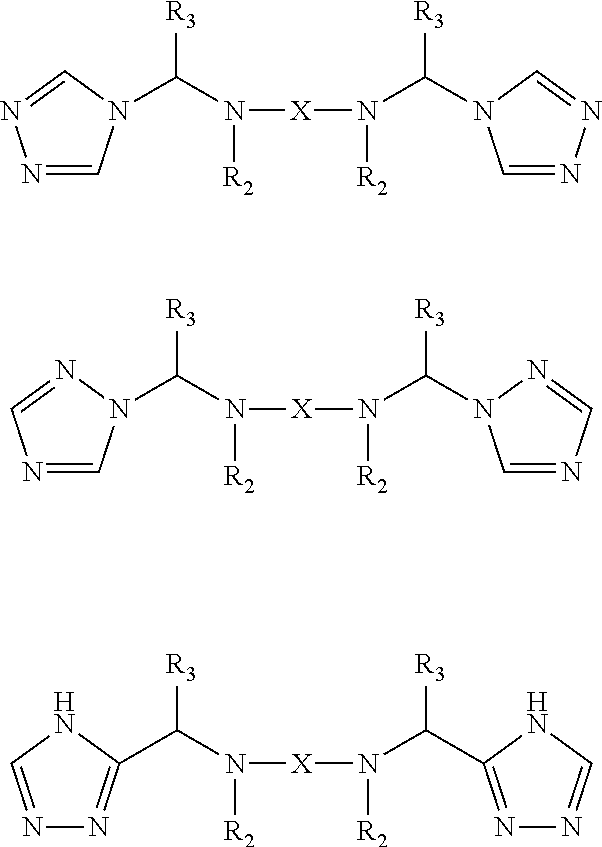Additive for lubricant compositions comprising a sulfur-containing and a sulfur-free organomolybdenum compound, and a triazole or a derivatized triazole
a technology of organomolybdenum compound and additive, which is applied in the direction of additives, lubricant compositions, petroleum industry, etc., can solve the problems of limited level of organomolybdenum compounds that can be used in lubricants, cu, pb or both may be problematic for corrosion, and the effect of reducing mo and reducing corrosion
- Summary
- Abstract
- Description
- Claims
- Application Information
AI Technical Summary
Benefits of technology
Problems solved by technology
Method used
Image
Examples
examples 1a thru 3c
[0133]Corrosivity of lubricants towards copper and lead metals was evaluated using the high temperature corrosion bench test (HTCBT) according to the ASTM D 6594 test method. Details of the test method can be found in the annual book of ASTM standards. For the test specimen 100±2 grams of lubricant was used. Four metal specimens of copper, lead, tin and phosphor bronze were immersed in a test lubricant. The test lubricant was kept at 135° C. and dry air was bubbled through the lubricant at 5±0.5 L / h for 1 week. API CJ-4 specifications for heavy duty diesel engine oil limits the metal concentration of copper and lead in the oxidized oil as per ASTM D 6594 test methods to 20 ppm maximum and 120 ppm maximum respectively. After the test, the lubricants were analyzed for the Cu and Pb metal content in the oil using inductive coupled plasma (ICP) analytical technique.
[0134]In Table 1, “base blend” is SAE 15W-40 viscosity grade fully formulated heavy duty diesel engine oil consisting of on...
examples 4 thru 29
[0135]In Table 2-6, “base blend” is SAE 0W-20 viscosity grade fully formulated engine oil consisting of one or more base oils, dispersants, detergents, VI Improvers, antioxidants, antiwear agents, pour point depressants and any other additives such that when combined with the invention makes a fully formulated motor oil. Base blend is then further formulated as described in the examples shown in table 2-6.
[0136]Corrosivity of these formulations towards copper and lead metals was evaluated using high temperature corrosion bench test (HTCBT) according to the ASTM D 6594 test methods and modified HTCBT method. In the modified HTCBT method, The test lubricant was kept at 165° C. and dry air was bubbled through the lubricant at 5±0.5 L / h for 48 hours. After the test, the lubricants were analyzed for the Cu and Pb metal in the oil using inductive coupled plasma (ICP) analytical technique.
[0137]A, B, and C are as described previously. Molybdenum dithiocarbamate (D) is a commercial mixed tr...
examples 30 thru 33
[0139]In Table 7, “base blend” is SAE 15W-40 viscosity grade fully formulated heavy duty diesel engine oil consisting of one or more base oils, dispersants, detergents, VI Improvers, antioxidants, antiwear agents, pour point depressants and any other additives such that when combined with the invention makes a fully formulated motor oil. Base blend is then further formulated as described in the examples 30-33.
[0140]Corrosivity of these formulations towards copper and lead metals was evaluated using high temperature corrosion bench test (HTCBT) according to the ASTM D 6594 test methods. Details of the test method can be found in the annual book of ASTM standards. For the test specimen 100±2 grams of lubricant was used. Four metal specimens of copper, lead, tin and phosphor bronze were immersed in a test lubricant. The test lubricant was kept at 135° C. and dry air was bubbled through at 5±0.5 L / h for 1 week. API CJ-4 specifications for heavy duty diesel engine oil limits the metal co...
PUM
 Login to View More
Login to View More Abstract
Description
Claims
Application Information
 Login to View More
Login to View More - R&D
- Intellectual Property
- Life Sciences
- Materials
- Tech Scout
- Unparalleled Data Quality
- Higher Quality Content
- 60% Fewer Hallucinations
Browse by: Latest US Patents, China's latest patents, Technical Efficacy Thesaurus, Application Domain, Technology Topic, Popular Technical Reports.
© 2025 PatSnap. All rights reserved.Legal|Privacy policy|Modern Slavery Act Transparency Statement|Sitemap|About US| Contact US: help@patsnap.com


